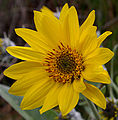
Eriophyllum lanatum, with the common names common woolly sunflower, Oregon sunshine and golden yarrow, is a common, widespread, North American plant in the family Asteraceae.

Xerophyllum tenax is a North American species of plants in the corn lily family. It is known by several common names, including bear grass, soap grass, quip-quip, and Indian basket grass.

Linum lewisii is a perennial plant in the family Linaceae, native to western North America.

Purshia tridentata, with the common name bitterbrush, is a shrub in the genus Purshia of the family Rosaceae. It is native to mountainous areas of western North America.

Grindelia squarrosa, also known as a curly-top gumweed or curlycup gumweed, is a small North American biennial or short-lived perennial plant.

Fritillaria pudica, the yellow fritillary, is a small perennial plant found in the sagebrush country in the western United States and Canada. It is a member of the lily family Liliaceae. Another common name is "yellow bells", since it has a bell-shaped yellow flower. It may be found in dryish, loose soil; it is amongst the first plants to flower after the snow melts, but the flower does not last very long; as the petals age, they turn a brick-red colour and begin to curl outward. The flowers grow singly or in pairs on the stems, and the floral parts grow in multiples of threes. The species produces a small corm, which forms corms earning the genus the nickname 'riceroot'. During his historic journey, Meriwether Lewis collected a specimen while passing through Idaho in 1806.
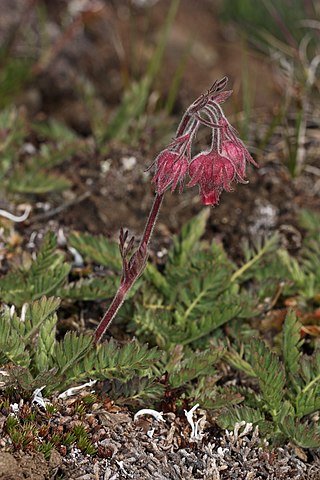
Geum triflorum, commonly known as prairie smoke, old man's whiskers, torchflower, three-sisters, long-plumed purple avens, lion's beard, or three-flowered avens, is a spring-blooming perennial herbaceous plant of the Rosaceae family. It is a hemiboreal continental climate species that is widespread in colder and drier environments of western North America, although it does occur in isolated populations as far east as New York and Ontario. It is particularly known for the long feathery plumes on the seed heads that have inspired many of the regional common names and aid in wind dispersal of its seeds.

Adenocaulon bicolor, the American trailplant, trailplant, pathfinder, or silver-green, is a flowering plant in the family Asteraceae, native to North America. It is found in southern Canada and across the northern and western United States. It is the only species of Adenocaulon native to the United States or Canada. The genus name Adenocaulon is derived from Greek, and refers to the glandular stem. The English name "Pathfinder" was given to this species, because if you walk through a patch of its leaves you will find the path you made through them, with some of the white undersides of the leaves having been exposed, by them having been twisted. Over time, the plant will turn its leaves back with the green side up, and the white side down.

Balsamorhiza is a genus of plants in the family Asteraceae known commonly as balsamroots. These are perennials with fleshy taproots and caudices bearing erect stems and large, basal leaves. Atop the tall stems are showy yellow sunflower-like blooms. Balsamroots are native to western North America.

Gaillardia aristata is a North American species of flowering plant in the sunflower family, known by the common names common blanketflower and common gaillardia. This perennial wildflower is widespread across much of North America, from Yukon east to Québec and south as far as California, Arizona, Illinois, and Connecticut, although it may be naturalized rather than native in parts of that range. It is also naturalized in scattered locations in Europe, Australia, and South America.
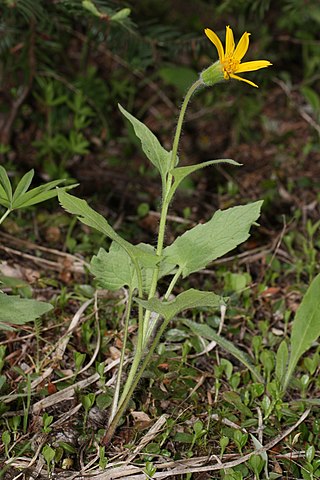
Arnica cordifolia is a species of arnica in the sunflower family, known by the common name heartleaf arnica. It is native to western North America.
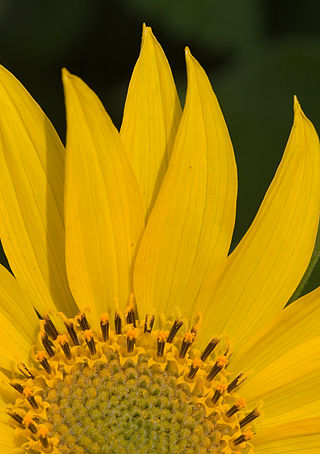
Balsamorhiza deltoidea is a species of flowering plant in the sunflower tribe of the plant family Asteraceae known by the common name deltoid balsamroot. It is native to western North America from British Columbia to California, where it grows in many types of generally mountainous habitat.
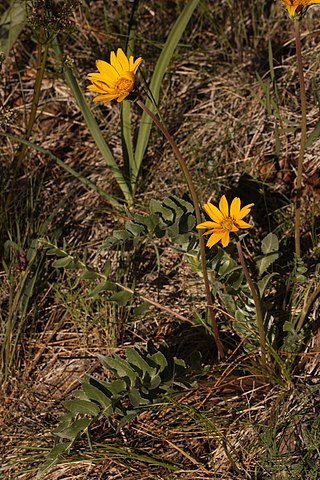
Balsamorhiza sericea is a species of flowering plant in the tribe Heliantheae of the family Asteraceae known by the common name silky balsamroot. It is native to the Klamath Mountains of northwestern California and southwestern Oregon, with additional populations in the Blue and Steens Mountains in eastern Oregon. It grows in rocky areas, sometimes on serpentine soils.

Bistorta bistortoides is a perennial herb in the buckwheat and knotweed family Polygonaceae.

Lupinus sericeus is a species of flowering plant in the legume family known by the common name silky lupine or Pursh's silky lupine. It is native to western North America from British Columbia to Arizona and east to Alberta and Colorado.

Balsamorhiza hookeri is a North American species of perennial plant in the family Asteraceae. It grows in the Great Basin and neighboring regions in the Western United States. It is found in Washington, Oregon, California, Idaho, Nevada, Utah, and Arizona.
Balsamorhiza rosea is a North American species of plants in the sunflower tribe within the aster family. It is native to the northwestern United States, in Washington and Oregon.
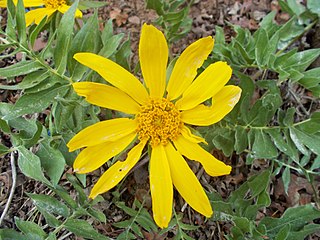
Balsamorhiza macrophylla is a North American species of plants in the tribe Heliantheae of the family Asteraceae. The species is native to the northwestern United States, in Idaho, Montana, Wyoming, Utah, and Oregon. It grows in sagebrush scrublands and conifer forests. It sometimes hybridizes with Balsamorhiza sagittata.
Balsamorhiza lanata, with the common name lanate balsamroot, is a species of plant in the tribe Heliantheae of the family Asteraceae native to California.

Wyethia amplexicaulis is a common herbaceous perennial plant from the northwestern United States called northern wyethia, northern mule ears, or black sunflower. Because of its tendency to grow together in dense colonies and its large, showy flowering heads it is a well known western wildflower that is often photographed. It is disliked by range managers because its leaves are not very palatable to large herbivores including livestock.




